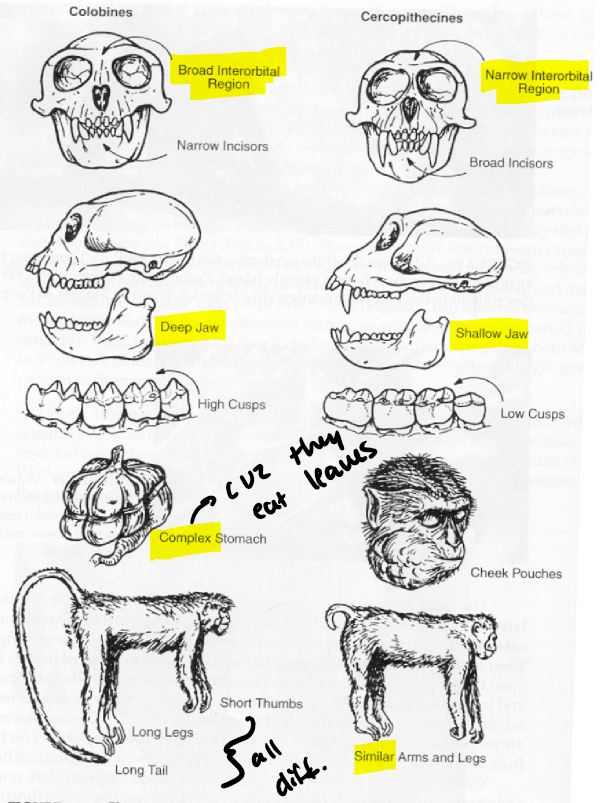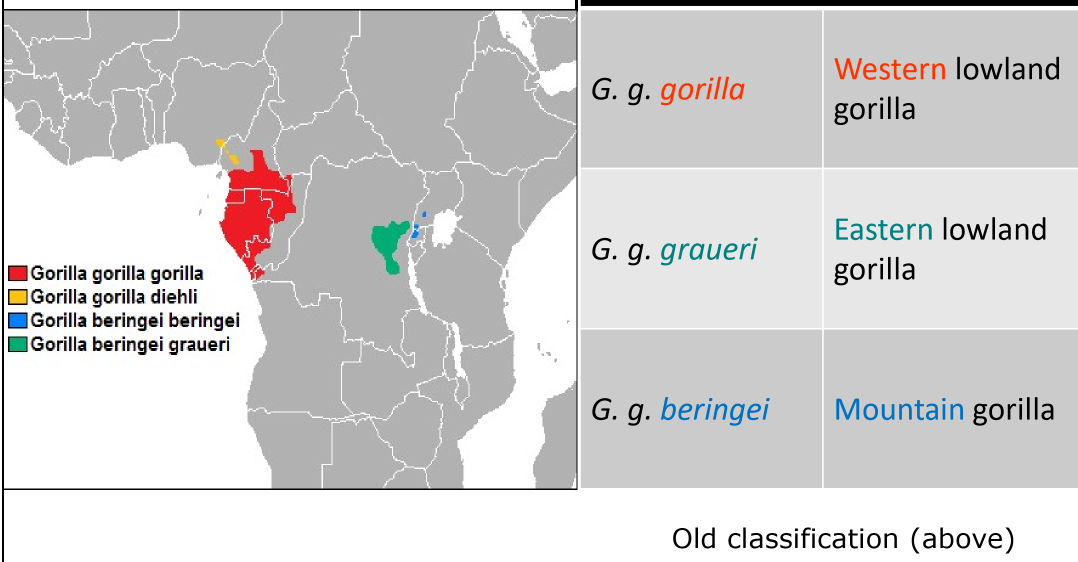Anthro 311- Taxonomy
1/50
There's no tags or description
Looks like no tags are added yet.
Name | Mastery | Learn | Test | Matching | Spaced |
|---|
No study sessions yet.
51 Terms
suborder of primates
strepsirrhini
haplorhini
infraorders of strepsirhini
Lemuriformes
Lorisiformes
infraorders of haplorhini
Platyrrhini
Catarrhini
Tarsiiforms
superfamily of Lemuriformes
Lemuriodea
superfamily of Lorsiformes
Lorsiodea
superfamily of Platyrrhini
Ceboidea
superfamily of Caratyrrhini
Cecopithecoidea
Hominoidea
superfamily of Tarsiiformes
Tarisoidea
Family of Lemuriodea
Cheriogaleidae
Lepilemuridae
Lemuridae
Daubentonidae
Indriidae
Family of Lorisodea
Lorisidae
Galagidae
Family of Ceboidea
Aotidae
Callitrichidae
Pitheciidae
Atelidae
Cebidae
Family of Cercopithecoidea
Cercopithecidae
Family of Tarsiodea
Tarsiidae
Subfamily of Cercopithecidae
Cerpithecinae
Colobinae
Family of Homoidea
Hylobatidea
Hominidae
Subfamily of Hominidae
ponginae
gorillinae
homininae
genus of:
ponginae
gorillinae
homininae
ponginae- Pongo
gorillinae- Gorilla
homininae- Homo + Pan
Strepsirhini characterisitics:
examples
distribution?
noc/di?
eye features
nose?
ears/lip?
dental formula?
locomotion
Distribution: only in old world
Nocturnal (mostly)
Large eyes
Tapetum (layer of cells under the retina, causes 'eye shine')
Wet nose (rhinarium)
Relays on scent marking
Independently mobile ears
Immobile upper lip
Inexpensive face
Dental formula: 2.1.3.3
Vertical clinging + leaping
Infraorder- Lemuriformes characteristics:
distribution
unique feature
Distribution: only in Madagascar
Among world's smallest primates
Family- Cheriogaleidae characteristics
examples?
habitat?
noc/di?
social life?
diet?
unique features?
Size?
Terrestrial?
Dwarf, mouse, fork-crowned lemurs
arboreal
Smallest primates
Nocturnal
Solitary
Omnivoruses (focus on insects)
X Terrestrial
Family- Lepilemuridae characteristics:
example
habitat?
size?
noc/di?
social life?
diet?
Unique characteristic?
Terrestrial?
Sportive lemurs
Arboreal
small- medium
Mostly nocturnal
Solitary
Folivores
decrease metabolic rate
X Terrestrial
Family- Lemuridae characteristics:
examples?
habitat?
size?
noc/di?
diet?
social life?
Unique characteristic?
Terrestrial?
Ring-tailes, brown, ruffed lemurs
Arboreal + terrestrial
Medium
Diurnal
Diverse diet (mostly omi)
Diverse social organization (mostly social)
scent marking
Terrestrial
Family- Daubentoniidae (aye aye) characteristics:
noc/di?
social life?
diet?
unique features?
symbol?
Size?
Terrestrial?
Nocturnal
Solitary
Omnivores/insects
Continuously growing incisors
Bony middle finger
Symbol of death
medium
X Terrestrial
Family- Indriidae characterisitcs:
examples?
habitat?
size?
noc/di?
diet?
mono/poly?
Social life?
Unique characteristic?
Terrestrial?
Woolly lemurs + sifakas
Arboreal + terrestrial
Medium-large
Mostly diurnal but mixes
wooly lemurs nocturnal
Folivores
Mostly monogamous
family
loud calls
Terrestrial
Infraorder- Lorisiiformes characteristics:
common ancestor?
social?
diet?
unique features?
distribution?
Share a common ancestor w/ lemurs in Eocene
solitary
Diet: insects + fruit
Lorises are regarded as “extreme” primates because of their huge eyes, deliberate locomotion, small infants, and their distinctive toxic bites
Hold many primitive traits
Asia + Africa
Family- Lorisidae characteristics:
examples?
distribution?
habitat?
noc/di?
unique feature?
size
diet?
Lorises, pottos, angwantibos
Central Africa + S/SE Asia
Lorisidae are found in Asia (Lorises) + Africa (loris related species)
Arboreal
Nocturnal
Slow climbers
Only primate that is poisonous
Has venom--> lifts arms to release venom after biting
small
omnivores
Family- Galagidae characterisitcs:
example?
distribution?
habitat
noc/di?
unique features?
size
diet?
Galagos (bush babies)
Mainland Africa
Galagidae (Galagos) are only in Africa
Arboreal
Nocturnal
fast, vertical slinger + leapers= good for tree-dwelling life
small
omnivores
Haplorhini characterisitics:
examples?
noc/di?
nose?
facial features?
eye/lip features?
Tarsiers, monkeys, apes
All diurnal (expect Tarsiers + 1 monkey--> owl monkey)
Dry noses
Less reliance on olfaction than strepsirrhines
X have tapetum
Flatter faces
Reduces sense of hearing
Mobile upper lip + highly expressive faces
Family- Tarsiidae characterisitcs:
genus number?
distribution?
facial features?
bones?
mono/poly?
Tapetum?
Mono/poly?
locomotion?
1 living genus
But have 3 species now
SE Asia
Large eyes + ears
Lack tapetum lucidum
Diff eye-brain (thalamus) connections than strepsirrhines + monkeys
Elongated tarsus bone in foot--> running + jumping
Mono OR male/multi-female groups
vertical clinging + leaping
Infraorder- Platyrhini characteristics:
OWM/NWM?
distribution
habitat?
size?
all have what body feature?
unique eye feature?
dental formula?
Part of new world
Distribution:
Mexico
Central + South America
All arboreal
Smaller body size than OWM
All have tails
Variable color vision
Male--> colorblind
Females--> X colorblind
Dental formula: 2.1.3.3 (36 teeth)
Family- Aotidae characteristics:
example?
habitat?
noc/di?
vision?
mono/poly?
parental?
Territorial?
size
diet
Monotypic
Owl monkeys
Arboreal
Only nocturnal monkey
1 of 2 nocturnal haplorhines
Monochromatic vision
High rod to cone ratio
More rods than cones
large eyes
Monogamous
male parental care
Territorial
small
frugivores + insectivorse
Family- Callitrichidae (Claw) characteristics:
examples?
smallest ___?
physical features?
mono/poly?
parental features?
Territorial?
size?
diet?
Includes:
Marmosets
Tamarins
Smallest monkeys
NOT smallest Primates
Claws, X nails (except big toe)
Monogamous + cooperative polyandrous groups
Female gets 2 male mates
Twins as offspring--> mostly fraternal twins
Male cares for infants
Low sexual dimorphism
Territorial
small
frugivores + insectivorse + sap feeding
Family- Pitheciidae characterisitcs:
examples?
habitat?
noc/di?
size?
diet?
social?
unique features?
Includes:
Monkeys
titis
Sakis
Uakaris
Arboreal
Diurnal
Small-medium size
Diverse diets: folivores + frugivores
Diverse social organization:
Titis--> monogamous
Other--> polygamous
Multi-male/multi-female
Decrease in sexual dimorphism
strong pair bonds + colorful faces
Family- Atelidae :
examples?
habitat?
noc/di?
mono/poly?
social?
unique features?
size?
diet?
spider monkey + howler monkey
Arboreal
Diurnal
Polygamous
Multi-male/multi-female
Fission-fusion societies
loud vocal communication--> howler monkeys
Prehensile tails--> used tails as grippers + are tactile
medium-large
folivores + frugivores
Family- Cebidae characterisitcs:
examples?
habitat?
noc/di?
diverse in what? list 3
unique features?
size
diet?
Territorial?
Includes:
Capuchin monkey
Squirrel monkeys
Arboreal
Diurnal
Diverse appearance
Diverse mating
Diverse social organizations
Very vocal
X used to humans
high cognition + tool use
medium-large
Omnivore (but diverse)
X Territorial
Subfamily- Cercopithecinae characteristics:
examples?
distribution?
noc/di?
size?
diverse on what? list 2
habitat?
features btw males + females?
unique feature?
Ex. Baboons, maqcaques, guenons
Distribution: Africa + Asia
All diurnal
Many species are large bodied
Diverse social organizations, many multi-males/multi-females
Diverse diets
wide range of habitats
Some species have extreme sexual dimorphism
More ground-dwelling species than other primate group
Subfamily- Colobinae characteristics:
examples?
distribution?
noc/di?
habitat?
size?
diet?
social?
Colobus, langurs, leaf + odd nosed monkeys
Distribution: Africa (colobus) + Asia (leaf + odd-nosed monkeys)
All diurnal
Mostly arboreal
Many species are large bodied
Wide range of habitats
Folivorous
Complex stomach, energy minimizers
Diverse social organizations
Cercopithecinase vs. Colobinae:
interorbital region
incisors
Jaw
molars/cusps
stomach
legs + hands
Colobinae | Cercopithecinase |
Broad interorbital region | Narrow Interorbital region |
Narrow incisors | Broad incisors |
Deep jaw | Shallow jaw |
High molars/cusps | Low molars/cusps |
Complex stomach | Cheek pouches |
Long legs + tail/short thumbs | Same size arms + legs |

Colobinea genera, list 3
Colobus
Pilicolobus
Procolobus
family of Hominiodea
Hylobatidae
Hominidae
Superfamily- Hominoidea characteristics:
examples?
tails?
size + weight?
brain to body ratio?
posture?
gestation + maturation?
Apes + humans
X tails
Largest size + weight
Largest brain to body ratio
More upright posture
Longer gestation + maturation
Family- Hylobatidae:
example?
what is the 2 genera?
distribution?
mono/poly?
Territorial?
yes/no duetting?
locomotion?
brachiation anatomical adaptations? list 5
Lesser apes
2 genera
Hylobates (gibbons)
Symphalangus (siamangs)
Distribution: SE Asia
Mono
Territorial
Duetting
Suspensory locomotion:
Brachiation Anatomical adaptations
Long, strong arms
Elongated, hook-like fingers
Shorten, reduced thumbs
Short hind limbs
Erect, inflexible spine
what does Convergent evolution mean?
Suspensory locomotion
Distantly related species converge on similar solution to same ecological pressure (strier)
Subfamily- Ponginae
examples?
distribution
habitat?
social?
diet?
locomotion type?
Orangutans
Asian great ape
Only found in Borneo + Sumatra
Arboreal
Solitary
Frugivorous
Quadrumanual/Quandrymanous locomotion
Subfamily- Gorillinae
examples
unique feature?
habitat?
diet?
Gorillas
African great ape
Largest primate
Terrestrial
Highly folivorous
Gorilla distribution for 4 subspecies

Homininae genus. list 2
Genus- Pan
Genus- Homo
Pan troglodytes:
example
diet
hunting?
tools?
sex roles?
aggression?
chimpanzees
Omni
Hunt (especially red colobus)
Tool use
Male philopatric + male dominant
High levels of aggression
Pan paniscus
example?
diet?
hunting?
tools?
sex roles?
aggression?
bononos
Frug
Hunting (recent evidence)
X tool use outside of captivity
Male philopatric + female dominant
Low levels of aggression
Africa apes (Homininae) traits
habitat
social
arboreal + terrestrial
fission + fusion socities
bononos are more limited distribution
what family is humans under?
hominidae